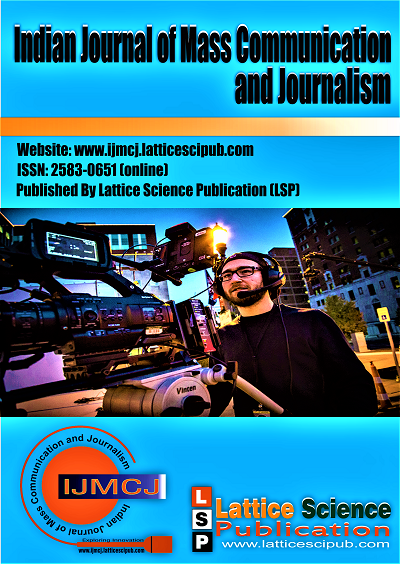Journalism and Advancing Human Rights: Suo Motu Cases in India
Main Article Content
Abstract
Journalism plays a pivotal role in advancing human rights. Newspapers and media not only make citizens aware of human rights, they are also key in reporting incidents of violation of these rights. In India, this journalistic responsibility is heightened manifold with the suo motu cognizance afforded through the National Human Rights Commission (NHRC). Applying suo motu, the NHRC issues orders and acts without being petitioned. As such, newspapers and media in India have the capacity to not just increase public awareness but also lead to direct remedial action. In this paper, NHRC suo motu cases registered in the study period of five months from April 2024 to August 2024 are examined. This includes a total of 65 eligible cases, of which 60% stem from 7 newspapers and 40% from 21 additional newspapers. Nearly three-quarters - 48 of the 65 - cases are reported from 7 states. The cases cover hazardous and illegal employment, rape and sexual offences, medical issues, negligence and mismanagement by authorities, police mistreatment, and other incidents. Four illustrative cases of deaths filed within the NHRC suo motu cognizance are presented in detail, reflecting the nature and content of grievances of human rights violations in India. These include sewer deaths, suicide due to police harassment, a police custody death, and death by electrocution. By understanding suo motu cases in the human rights context in India, journalists can gain perspective on their role in advancing the dignity of our society.
Downloads
Article Details

This work is licensed under a Creative Commons Attribution-NonCommercial-NoDerivatives 4.0 International License.
How to Cite
References
UN Human Rights Committee issues findings on India. (2024). India. Retrieved from https://india.un.org/en/275172-un-human-rights-committee-issues-findings-india
US Department of State, Bureau of Democracy, Human Rights and Labor. (2023). US. Retrieved from https://www.state.gov/wp-content/uploads/2024/04/5282672_INDIA-2023-HUMAN-RIGHTS-REPORT.pdf
Chandran, R. (2016, April 28). Much crime unreported in Indian cities, sexual harassment complaints ignored: survey. Thomas Reuters Foundation. Retrieved from https://reuters.com
National Human Rights Commission India. (2018). Retrieved from https://nhrc.nic.in/about-us/about-the-Organisation
Castaldo, J. S. (2015, March 13). Civil Litigation: Obtaining appellate review of a sua sponte order. NY Daily Record. Retrieved from https://nydailyrecord.com/2015/03/13/civil-litigation-obtaining-appellate-review-of-a-sua-sponte-order/
Milani, A., Smith, M. (2001). Playing God: A Critical Look at Sua Sponte Decisions by Appellate Courts. Tennessee Law Review. 69: 245.
Couch, D. (2013). Sua sponte: The Forging of a Modern American Ranger. Penguin. ISBN 978-0-425-25360-1. https://www.goodreads.com/book/show/13542418-sua-sponte
Human Rights Commissions Network. (2018). Retrieved from https://hrcnet.nic.in/HRCNet/public/Home.aspx
United Nations. (1948). Universal Declaration of Human Rights. Retrieved from https://www.un.org/sites/un2.un.org/files/2021/03/udhr.pdf
Apadoca, C. (2007). The Whole World Could Be Watching: Human Rights and the Media. Journal of Human Rights. 6(147), 147-164. https://doi.org/10.1080/14754830701334632
Cmiel, K. (2004). The Recent History of Human Rights. The American Historical Review. 109(1), 117-135. https://doi.org/10.1086/530153
Adel Abdullin, Ainur Gilmullin, Lenara Klimovskaya, Vagip Abdrashitov, On the Role of Modern Doctrines on Human Rights (International Legal Examination). (2019). In International Journal of Innovative Technology and Exploring Engineering (Vol. 9, Issue 1, pp. 5155–5158). https://doi.org/10.35940/ijitee.a9219.119119
Ratan Singh Solanki, Bhupal Bhattacharya, Right to Dignity and Human Rights: Tracing the Values from Indian Perspective. (2019). In International Journal of Recent Technology and Engineering (Vol. 8, Issue 2S7, pp. 365–368). https://doi.org/10.35940/ijrte.b1067.0782s719
Joshi, S. C., Gupta, K., & Manektala, S. (2022). Misinformation, Public Opinion, and the Role of Critical Thinking. In International Journal of Management and Humanities (Vol. 8, Issue 9, pp. 15–18). https://doi.org/10.35940/ijmh.i1483.058922
Guseinova, A. A., & Zayni, R. L. (2019). Visual Content as an Important Element in the Modern Journalism. In International Journal of Engineering and Advanced Technology (Vol. 9, Issue 1, pp. 7490–7492). https://doi.org/10.35940/ijeat.a3124.109119 `





